1、首先问自己一个问题,为啥要读SpringBoot源码呢?
像SpringBoot,你难道不好奇他的自动化配置、IOC和AOP的实现原理吗?
带着上面的问题,我们来Debug看看!
2、环境准备
Ⅰ、maven依赖关系(不同的SpringBoot版本、不同的依赖关系,运行结果会不一样,因为SpringBoot会自动配置)
<dependencies>
<dependency>
<groupId>org.springframework.boot</groupId>
<artifactId>spring-boot-starter-data-redis</artifactId>
</dependency>
<dependency>
<groupId>org.springframework.boot</groupId>
<artifactId>spring-boot-starter-web</artifactId>
</dependency>
<dependency>
<groupId>org.mybatis.spring.boot</groupId>
<artifactId>mybatis-spring-boot-starter</artifactId>
<version>2.1.4</version>
</dependency>
<dependency>
<groupId>org.springframework.boot</groupId>
<artifactId>spring-boot-starter-aop</artifactId>
</dependency>
<dependency>
<groupId>io.springfox</groupId>
<artifactId>springfox-boot-starter</artifactId>
<version>3.0.0</version>
</dependency>
<dependency>
<groupId>mysql</groupId>
<artifactId>mysql-connector-java</artifactId>
<scope>runtime</scope>
</dependency>
<dependency>
<groupId>org.projectlombok</groupId>
<artifactId>lombok</artifactId>
<optional>true</optional>
</dependency>
<dependency>
<groupId>cn.hutool</groupId>
<artifactId>hutool-all</artifactId>
<version>5.7.2</version>
</dependency>
<dependency>
<groupId>com.baomidou</groupId>
<artifactId>mybatis-plus-boot-starter</artifactId>
<version>3.4.0</version>
</dependency>
<dependency>
<groupId>com.baomidou</groupId>
<artifactId>mybatis-plus-generator</artifactId>
<version>3.4.0</version>
</dependency>
<dependency>
<groupId>org.apache.commons</groupId>
<artifactId>commons-pool2</artifactId>
<version>2.10.0</version>
</dependency>
<dependency>
<groupId>org.springframework.boot</groupId>
<artifactId>spring-boot-starter-test</artifactId>
<scope>test</scope>
</dependency>
</dependencies>
Ⅱ、Debug前的准备
- clean
- compile
- install
3、开始调试
就像我们学习C语言时的HelloWorld一样,SpringBoot也有一个开场白:
package com.study.redis; import org.springframework.boot.SpringApplication; import org.springframework.boot.autoconfigure.SpringBootApplication; /** * @author lemon */ @SpringBootApplication public class RedisApplication { public static void main(String[] args) { SpringApplication.run(RedisApplication.class, args); } }
然后我们Ctrl+鼠标左键点进SpringApplication的run方法可以看到下图:
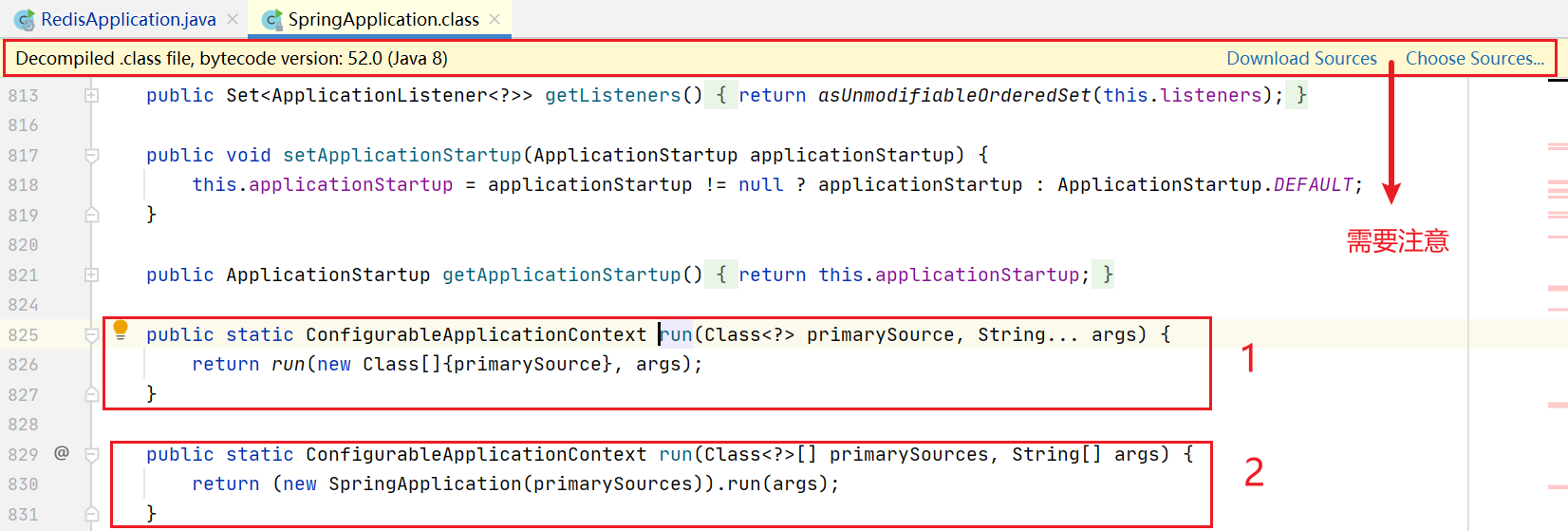
首先是调用形参为单个class的run方法,然后调用形参为class数组形式的run方法。
另外需要注意的是上面的那个Decompiled .class file,bytecode version: 52.0(Java 8) Download Sources Choose Sources...
为什么要注意这个呢,因为现在是对.class文件Debug,而不是Java文件,稍后Debug就会出现错误:
Source code does not match the byte code
我们选择Download Sources,如若有必要可以再Choose Sources,选择刚刚下载的Sources,然后就会看到带注释的方法了:
/** * Static helper that can be used to run a {@link SpringApplication} from the * specified source using default settings. * @param primarySource the primary source to load * @param args the application arguments (usually passed from a Java main method) * @return the running {@link ApplicationContext} */ public static ConfigurableApplicationContext run(Class<?> primarySource, String... args) { return run(new Class<?>[] { primarySource }, args); } /** * Static helper that can be used to run a {@link SpringApplication} from the * specified sources using default settings and user supplied arguments. * @param primarySources the primary sources to load * @param args the application arguments (usually passed from a Java main method) * @return the running {@link ApplicationContext} */ public static ConfigurableApplicationContext run(Class<?>[] primarySources, String[] args) { return new SpringApplication(primarySources).run(args); }
这里最终实例化了一个SpringApplication对象,并调用它的run方法,我们先看看初始化函数:
/** * Create a new {@link SpringApplication} instance. The application context will load * beans from the specified primary sources (see {@link SpringApplication class-level} * documentation for details. The instance can be customized before calling * {@link #run(String...)}. * @param primarySources the primary bean sources * @see #run(Class, String[]) * @see #SpringApplication(ResourceLoader, Class...) * @see #setSources(Set) */ public SpringApplication(Class<?>... primarySources) { this(null, primarySources); } /** * Create a new {@link SpringApplication} instance. The application context will load * beans from the specified primary sources (see {@link SpringApplication class-level} * documentation for details. The instance can be customized before calling * {@link #run(String...)}. * @param resourceLoader the resource loader to use * @param primarySources the primary bean sources * @see #run(Class, String[]) * @see #setSources(Set) */ @SuppressWarnings({ "unchecked", "rawtypes" }) public SpringApplication(ResourceLoader resourceLoader, Class<?>... primarySources) { this.resourceLoader = resourceLoader; Assert.notNull(primarySources, "PrimarySources must not be null"); this.primarySources = new LinkedHashSet<>(Arrays.asList(primarySources)); this.webApplicationType = WebApplicationType.deduceFromClasspath(); this.bootstrapRegistryInitializers = getBootstrapRegistryInitializersFromSpringFactories(); setInitializers((Collection) getSpringFactoriesInstances(ApplicationContextInitializer.class)); setListeners((Collection) getSpringFactoriesInstances(ApplicationListener.class)); this.mainApplicationClass = deduceMainApplicationClass(); }
初始化函数就先看到这儿,等要用的时候我们再回来看,接下来我们来看run方法:
/** * Run the Spring application, creating and refreshing a new * {@link ApplicationContext}. * @param args the application arguments (usually passed from a Java main method) * @return a running {@link ApplicationContext} */ public ConfigurableApplicationContext run(String... args) { StopWatch stopWatch = new StopWatch(); stopWatch.start(); DefaultBootstrapContext bootstrapContext = createBootstrapContext(); ConfigurableApplicationContext context = null; configureHeadlessProperty(); SpringApplicationRunListeners listeners = getRunListeners(args); listeners.starting(bootstrapContext, this.mainApplicationClass); try { ApplicationArguments applicationArguments = new DefaultApplicationArguments(args); ConfigurableEnvironment environment = prepareEnvironment(listeners, bootstrapContext, applicationArguments); configureIgnoreBeanInfo(environment); Banner printedBanner = printBanner(environment); context = createApplicationContext(); context.setApplicationStartup(this.applicationStartup); prepareContext(bootstrapContext, context, environment, listeners, applicationArguments, printedBanner); refreshContext(context); afterRefresh(context, applicationArguments); stopWatch.stop(); if (this.logStartupInfo) { new StartupInfoLogger(this.mainApplicationClass).logStarted(getApplicationLog(), stopWatch); } listeners.started(context); callRunners(context, applicationArguments); } catch (Throwable ex) { handleRunFailure(context, ex, listeners); throw new IllegalStateException(ex); } try { listeners.running(context); } catch (Throwable ex) { handleRunFailure(context, ex, null); throw new IllegalStateException(ex); } return context; }
首先实例化了一个StopWatch对象:
/** * Construct a new {@code StopWatch}. * <p>Does not start any task. */ public StopWatch() { this(""); } /** * Construct a new {@code StopWatch} with the given ID. * <p>The ID is handy when we have output from multiple stop watches and need * to distinguish between them. * <p>Does not start any task. * @param id identifier for this stop watch */ public StopWatch(String id) { this.id = id; }
然后调用了start方法,我们看看它的start方法干了啥:
/** * Start an unnamed task. * <p>The results are undefined if {@link #stop()} or timing methods are * called without invoking this method first. * @see #start(String) * @see #stop() */ public void start() throws IllegalStateException { start(""); } /** * Start a named task. * <p>The results are undefined if {@link #stop()} or timing methods are * called without invoking this method first. * @param taskName the name of the task to start * @see #start() * @see #stop() */ public void start(String taskName) throws IllegalStateException { if (this.currentTaskName != null) { throw new IllegalStateException("Can't start StopWatch: it's already running"); } this.currentTaskName = taskName; this.startTimeNanos = System.nanoTime(); }
感觉啥也没干哈哈(菜鸟级理解)
接下来就是createBootstrapContext方法:
private DefaultBootstrapContext createBootstrapContext() { DefaultBootstrapContext bootstrapContext = new DefaultBootstrapContext(); this.bootstrapRegistryInitializers.forEach((initializer) -> initializer.initialize(bootstrapContext)); return bootstrapContext; }
首先实例化了一个DefaultBootstrapContext,调用的是默认的构造函数,无代码展示。
然后将bootstrapRegistryInitializer里面的每一个实例都初始化,那我们回来之前SpringApplication的构造函数:
this.bootstrapRegistryInitializers = getBootstrapRegistryInitializersFromSpringFactories();
@SuppressWarnings("deprecation")
private List<BootstrapRegistryInitializer> getBootstrapRegistryInitializersFromSpringFactories() {
ArrayList<BootstrapRegistryInitializer> initializers = new ArrayList<>();
getSpringFactoriesInstances(Bootstrapper.class).stream()
.map((bootstrapper) -> ((BootstrapRegistryInitializer) bootstrapper::initialize))
.forEach(initializers::add);
initializers.addAll(getSpringFactoriesInstances(BootstrapRegistryInitializer.class));
return initializers;
}
看到这个@SuppressWarnings("deprecation")注解,作者估计是不想用这个了吧。
可以看到initializers里面的元素都是从getSpringFactoriesInstances方法中来的:
private <T> Collection<T> getSpringFactoriesInstances(Class<T> type) { return getSpringFactoriesInstances(type, new Class<?>[] {}); }
private <T> Collection<T> getSpringFactoriesInstances(Class<T> type, Class<?>[] parameterTypes, Object... args) { ClassLoader classLoader = getClassLoader(); // Use names and ensure unique to protect against duplicates Set<String> names = new LinkedHashSet<>(SpringFactoriesLoader.loadFactoryNames(type, classLoader)); List<T> instances = createSpringFactoriesInstances(type, parameterTypes, classLoader, args, names); AnnotationAwareOrderComparator.sort(instances); return instances; }
首先它实例化了一个类加载器,其实也就是下面这个:
Thread.currentThread().getContextClassLoader()
然后通过SpringFactoriesLoade的LoadFactoryNames方法实例实例化了一个Set<String>集合:
/** * Load the fully qualified class names of factory implementations of the * given type from {@value #FACTORIES_RESOURCE_LOCATION}, using the given * class loader. * <p>As of Spring Framework 5.3, if a particular implementation class name * is discovered more than once for the given factory type, duplicates will * be ignored. * @param factoryType the interface or abstract class representing the factory * @param classLoader the ClassLoader to use for loading resources; can be * {@code null} to use the default * @throws IllegalArgumentException if an error occurs while loading factory names * @see #loadFactories */ public static List<String> loadFactoryNames(Class<?> factoryType, @Nullable ClassLoader classLoader) { ClassLoader classLoaderToUse = classLoader; if (classLoaderToUse == null) { classLoaderToUse = SpringFactoriesLoader.class.getClassLoader(); } String factoryTypeName = factoryType.getName(); return loadSpringFactories(classLoaderToUse).getOrDefault(factoryTypeName, Collections.emptyList()); }
最终还是调用的loadSpringFactories方法:
private static Map<String, List<String>> loadSpringFactories(ClassLoader classLoader) { Map<String, List<String>> result = cache.get(classLoader); if (result != null) { return result; } result = new HashMap<>(); try { Enumeration<URL> urls = classLoader.getResources(FACTORIES_RESOURCE_LOCATION); while (urls.hasMoreElements()) { URL url = urls.nextElement(); UrlResource resource = new UrlResource(url); Properties properties = PropertiesLoaderUtils.loadProperties(resource); for (Map.Entry<?, ?> entry : properties.entrySet()) { String factoryTypeName = ((String) entry.getKey()).trim(); String[] factoryImplementationNames = StringUtils.commaDelimitedListToStringArray((String) entry.getValue()); for (String factoryImplementationName : factoryImplementationNames) { result.computeIfAbsent(factoryTypeName, key -> new ArrayList<>()) .add(factoryImplementationName.trim()); } } } // Replace all lists with unmodifiable lists containing unique elements result.replaceAll((factoryType, implementations) -> implementations.stream().distinct() .collect(Collectors.collectingAndThen(Collectors.toList(), Collections::unmodifiableList))); cache.put(classLoader, result); } catch (IOException ex) { throw new IllegalArgumentException("Unable to load factories from location [" + FACTORIES_RESOURCE_LOCATION + "]", ex); } return result; }
我们先来看看cache是啥:
static final Map<ClassLoader, Map<String, List<String>>> cache = new ConcurrentReferenceHashMap<>();
很明细,里面是空的,接下来我们看看下面这句:
Enumeration<URL> urls = classLoader.getResources(FACTORIES_RESOURCE_LOCATION);
public static final String FACTORIES_RESOURCE_LOCATION = "META-INF/spring.factories";
通过Debug,我们得到如下结果:
算了,这个urls里面东西太多了,反正就是一些包相关信息,我们直接看result吧,反正信息都是从类加载器取出来的:
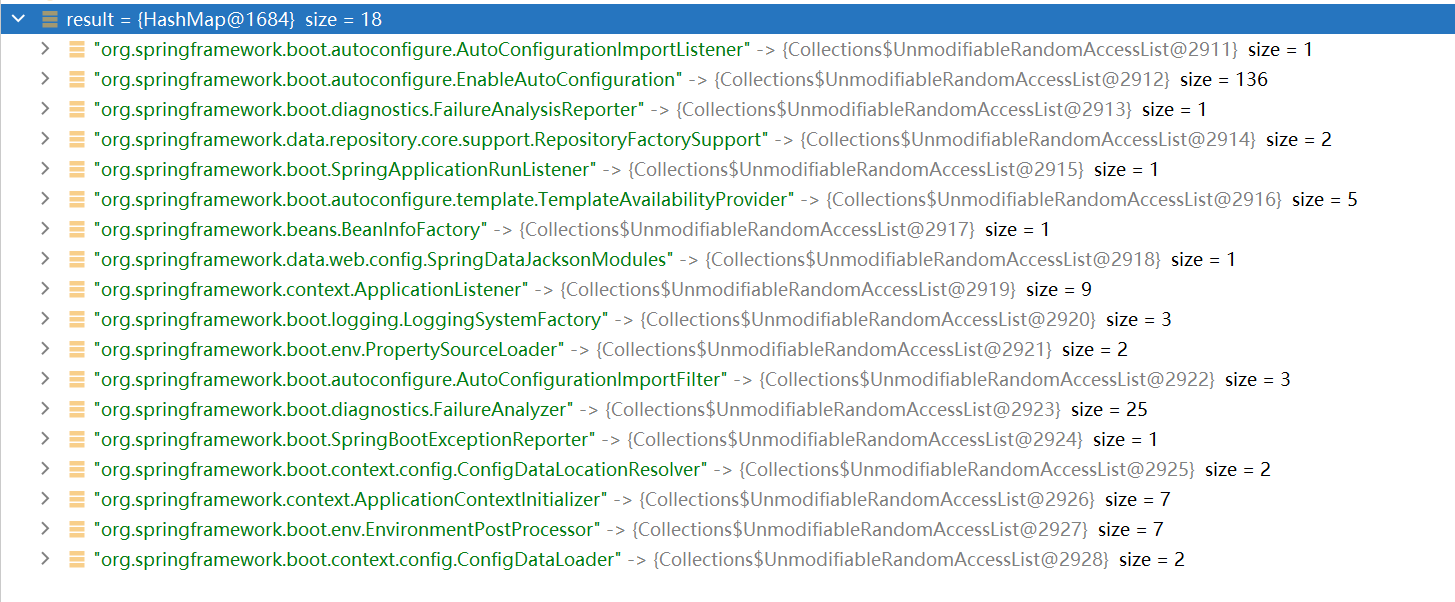
现在我们回到LoadFactoryNames方法,由于返回的result中没有对应Bootstrapper.class类型的键,所以返回一个空列表。
那我们再看看是否有对应的BootstrapRegistryInitializer.class类型的键,同样也没有。
所以初始化构造的bootstrapRegistryInitializer是一个空列表。
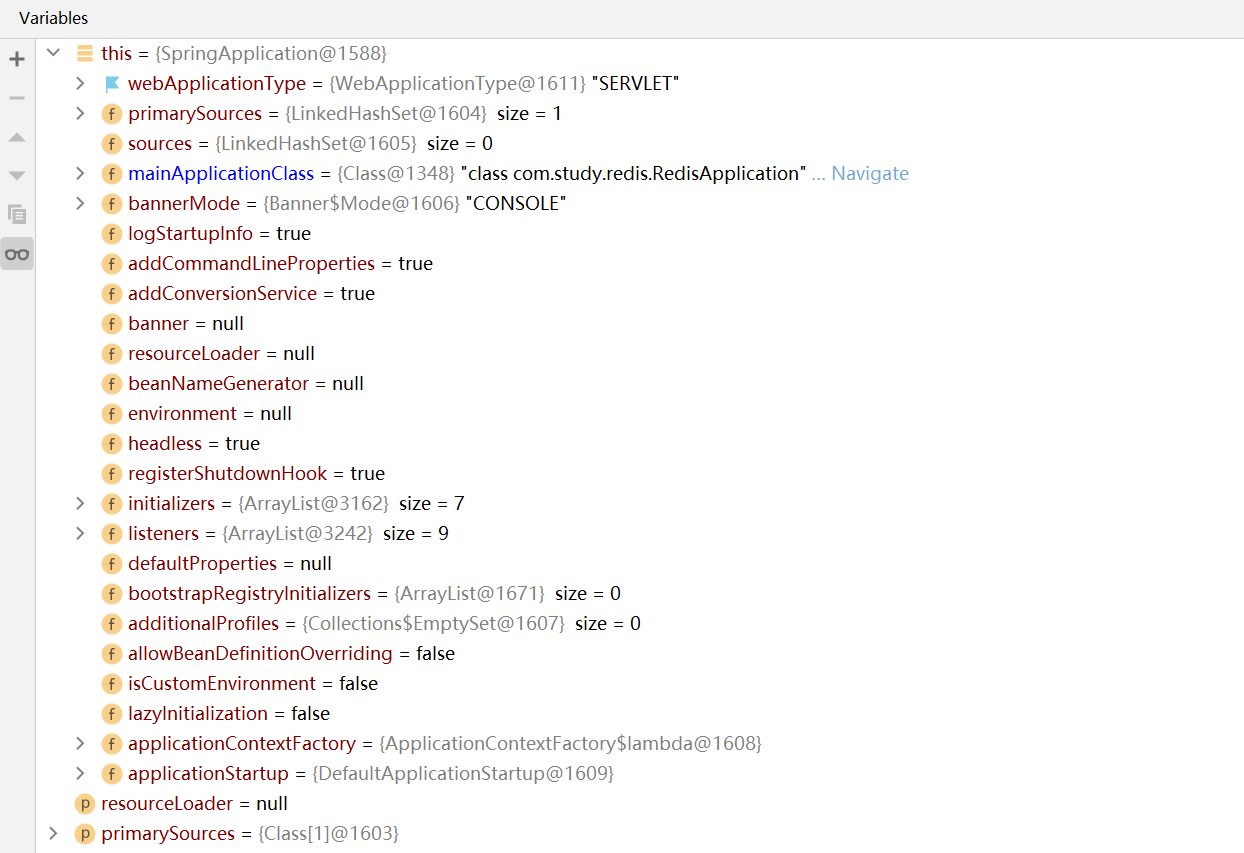
但是initializer和listeners有值:
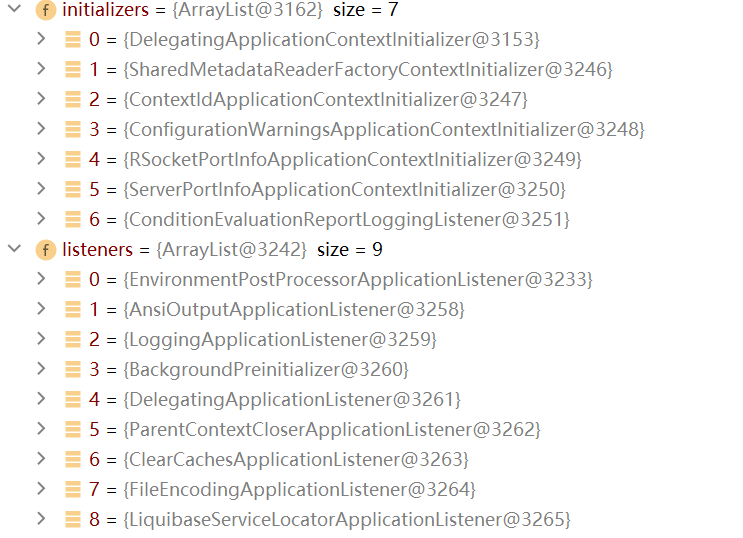
接下来我们回到createBootstrapContext方法,由于bootstrapRegistryInitializer是一个空列表,
所以该方法相当于直接返回一个默认的DefaultBootstrapContext,没有做其他操作。
现在再回到run方法中的configureHeadlessProperty方法:
private void configureHeadlessProperty() { System.setProperty(SYSTEM_PROPERTY_JAVA_AWT_HEADLESS, System.getProperty(SYSTEM_PROPERTY_JAVA_AWT_HEADLESS, Boolean.toString(this.headless))); }
这一步就简单的设置一下系统所属性,接下来我们看看getRunListeners方法:
private SpringApplicationRunListeners getRunListeners(String[] args) { Class<?>[] types = new Class<?>[] { SpringApplication.class, String[].class }; return new SpringApplicationRunListeners(logger, getSpringFactoriesInstances(SpringApplicationRunListener.class, types, this, args), this.applicationStartup); }
我们先看看构造函数:
SpringApplicationRunListeners(Log log, Collection<? extends SpringApplicationRunListener> listeners, ApplicationStartup applicationStartup) { this.log = log; this.listeners = new ArrayList<>(listeners); this.applicationStartup = applicationStartup; }
简单的赋值,没啥好说的,我们回到getSpringFactoriesInstances方法:

可以看到返回了一个listeners(EventPublishingRunlistener),这个我们稍后会用到。
接下来看看createSpringFactoriesInstances方法实例化对象:
@SuppressWarnings("unchecked")
private <T> List<T> createSpringFactoriesInstances(Class<T> type, Class<?>[] parameterTypes,
ClassLoader classLoader, Object[] args, Set<String> names) {
List<T> instances = new ArrayList<>(names.size());
for (String name : names) {
try {
Class<?> instanceClass = ClassUtils.forName(name, classLoader);
Assert.isAssignable(type, instanceClass);
Constructor<?> constructor = instanceClass.getDeclaredConstructor(parameterTypes);
T instance = (T) BeanUtils.instantiateClass(constructor, args);
instances.add(instance);
}
catch (Throwable ex) {
throw new IllegalArgumentException("Cannot instantiate " + type + " : " + name, ex);
}
}
return instances;
}
可以看到是通过类路径和类加载器来实例化对象的,我们再回到run方法:(该listeners中包含一个EventPublishListener对象)
listeners.starting(bootstrapContext, this.mainApplicationClass);
void starting(ConfigurableBootstrapContext bootstrapContext, Class<?> mainApplicationClass) { doWithListeners("spring.boot.application.starting", (listener) -> listener.starting(bootstrapContext), (step) -> { if (mainApplicationClass != null) { step.tag("mainApplicationClass", mainApplicationClass.getName()); } }); }
private void doWithListeners(String stepName, Consumer<SpringApplicationRunListener> listenerAction, Consumer<StartupStep> stepAction) { StartupStep step = this.applicationStartup.start(stepName); this.listeners.forEach(listenerAction); if (stepAction != null) { stepAction.accept(step); } step.end(); }
通过调用listeners的start方法,最终调用该实例的的listeners的starting方法,我们再看看step干了啥:
private static final DefaultStartupStep DEFAULT_STARTUP_STEP = new DefaultStartupStep(); @Override public DefaultStartupStep start(String name) { return DEFAULT_STARTUP_STEP; }
虽然方法名叫start,但是只是实例化一个DefaultStartupStep对象,接下来再看listener的starting方法(也就是EventPublishListener):
@Override public void starting(ConfigurableBootstrapContext bootstrapContext) { this.initialMulticaster .multicastEvent(new ApplicationStartingEvent(bootstrapContext, this.application, this.args)); }
我们再看看EventPublishListener的构造函数,他的属性是怎么赋值的:
public EventPublishingRunListener(SpringApplication application, String[] args) { this.application = application; this.args = args; this.initialMulticaster = new SimpleApplicationEventMulticaster(); for (ApplicationListener<?> listener : application.getListeners()) { this.initialMulticaster.addApplicationListener(listener); } }
可以看到initialMulticaster是SimpleApplicationEventMulticaster的实例,再看看ApplicationStartingEvent构造函数:
/** * Create a new {@link ApplicationStartingEvent} instance. * @param bootstrapContext the bootstrap context * @param application the current application * @param args the arguments the application is running with */ public ApplicationStartingEvent(ConfigurableBootstrapContext bootstrapContext, SpringApplication application, String[] args) { super(application, args); this.bootstrapContext = bootstrapContext; }
反正就是构造一个实例就完了,那我们再回到initialMulticaster的multicasEvent方法:
@Override public void multicastEvent(ApplicationEvent event) { multicastEvent(event, resolveDefaultEventType(event)); }
@Override public void multicastEvent(final ApplicationEvent event, @Nullable ResolvableType eventType) { ResolvableType type = (eventType != null ? eventType : resolveDefaultEventType(event)); Executor executor = getTaskExecutor(); for (ApplicationListener<?> listener : getApplicationListeners(event, type)) { if (executor != null) { executor.execute(() -> invokeListener(listener, event)); } else { invokeListener(listener, event); } } }
event就是ApplicationStartingEvent的一个实例,由于SimpleApplicationEventMulticaster的构造函数如下:
/** * Create a new SimpleApplicationEventMulticaster. */ public SimpleApplicationEventMulticaster() { }
所以Executor是空的,接下来我们看看getApplicationListeners方法:
/** * Return a Collection of ApplicationListeners matching the given * event type. Non-matching listeners get excluded early. * @param event the event to be propagated. Allows for excluding * non-matching listeners early, based on cached matching information. * @param eventType the event type * @return a Collection of ApplicationListeners * @see org.springframework.context.ApplicationListener */ protected Collection<ApplicationListener<?>> getApplicationListeners( ApplicationEvent event, ResolvableType eventType) { Object source = event.getSource(); Class<?> sourceType = (source != null ? source.getClass() : null); ListenerCacheKey cacheKey = new ListenerCacheKey(eventType, sourceType); // Potential new retriever to populate CachedListenerRetriever newRetriever = null; // Quick check for existing entry on ConcurrentHashMap CachedListenerRetriever existingRetriever = this.retrieverCache.get(cacheKey); if (existingRetriever == null) { // Caching a new ListenerRetriever if possible if (this.beanClassLoader == null || (ClassUtils.isCacheSafe(event.getClass(), this.beanClassLoader) && (sourceType == null || ClassUtils.isCacheSafe(sourceType, this.beanClassLoader)))) { newRetriever = new CachedListenerRetriever(); existingRetriever = this.retrieverCache.putIfAbsent(cacheKey, newRetriever); if (existingRetriever != null) { newRetriever = null; // no need to populate it in retrieveApplicationListeners } } } if (existingRetriever != null) { Collection<ApplicationListener<?>> result = existingRetriever.getApplicationListeners(); if (result != null) { return result; } // If result is null, the existing retriever is not fully populated yet by another thread. // Proceed like caching wasn't possible for this current local attempt. } return retrieveApplicationListeners(eventType, sourceType, newRetriever); }
我们来看看对应的event、eventType是什么:

source就是之前构造的SpringApplication实例:
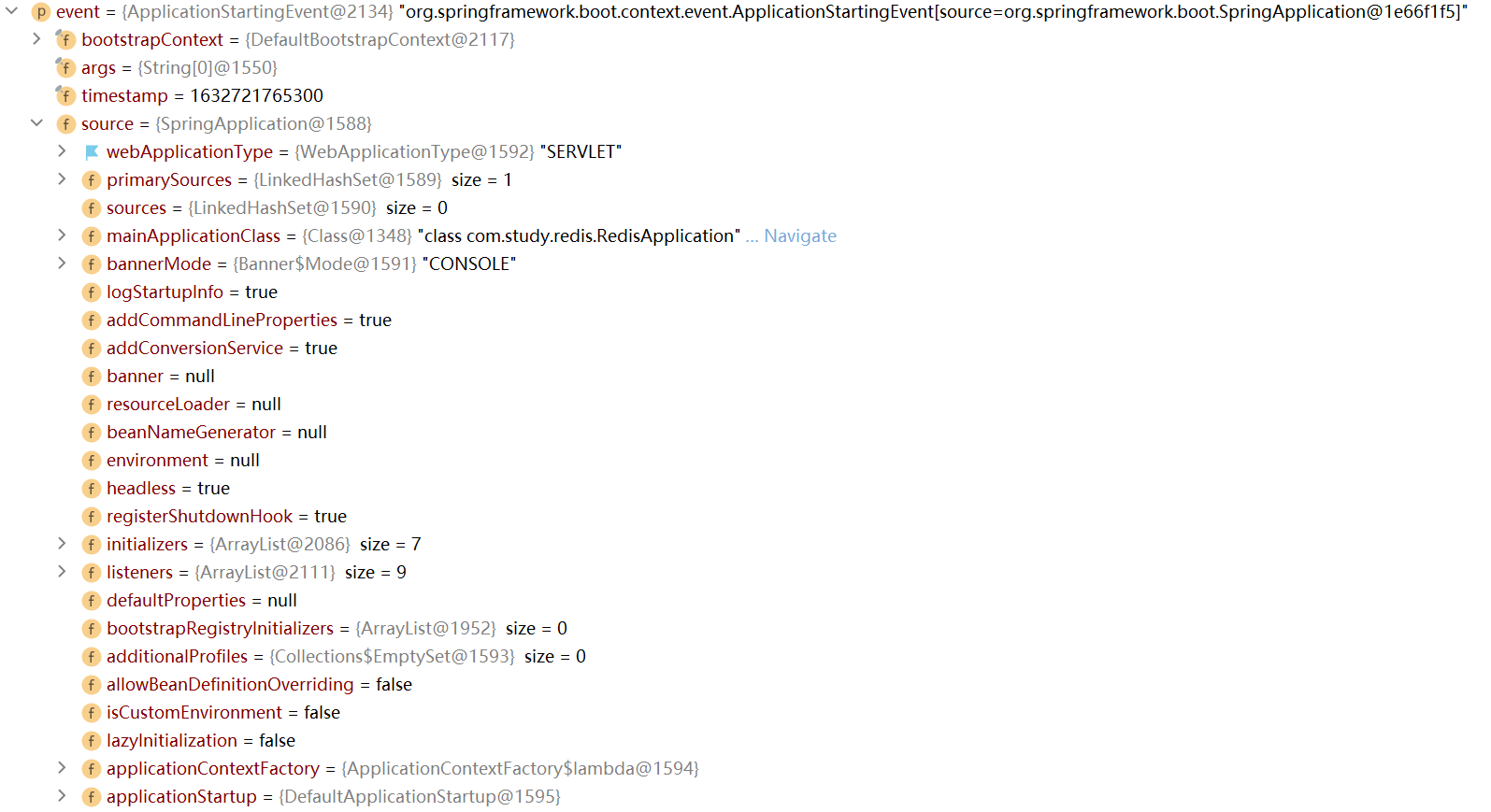
接下来根据eventType和sourceType创建了一个cacheKey:
public ListenerCacheKey(ResolvableType eventType, @Nullable Class<?> sourceType) { Assert.notNull(eventType, "Event type must not be null"); this.eventType = eventType; this.sourceType = sourceType; }
就是简单的赋值,没啥好说的,然后根据该key获取一个值:
CachedListenerRetriever existingRetriever = this.retrieverCache.get(cacheKey);
final Map<ListenerCacheKey, CachedListenerRetriever> retrieverCache = new ConcurrentHashMap<>(64);
由于retrieverCache是一个空的ConcurrentHashMap(),为啥要用并发Map,我们先不管。
由于existingRetriever是空的,并且beanClassLoader也是空的,所以我们直接看retrieveApplicationListeners方法:
/** * Actually retrieve the application listeners for the given event and source type. * @param eventType the event type * @param sourceType the event source type * @param retriever the ListenerRetriever, if supposed to populate one (for caching purposes) * @return the pre-filtered list of application listeners for the given event and source type */ private Collection<ApplicationListener<?>> retrieveApplicationListeners( ResolvableType eventType, @Nullable Class<?> sourceType, @Nullable CachedListenerRetriever retriever) { List<ApplicationListener<?>> allListeners = new ArrayList<>(); Set<ApplicationListener<?>> filteredListeners = (retriever != null ? new LinkedHashSet<>() : null); Set<String> filteredListenerBeans = (retriever != null ? new LinkedHashSet<>() : null); Set<ApplicationListener<?>> listeners; Set<String> listenerBeans; synchronized (this.defaultRetriever) { listeners = new LinkedHashSet<>(this.defaultRetriever.applicationListeners); listenerBeans = new LinkedHashSet<>(this.defaultRetriever.applicationListenerBeans); } // Add programmatically registered listeners, including ones coming // from ApplicationListenerDetector (singleton beans and inner beans). for (ApplicationListener<?> listener : listeners) { if (supportsEvent(listener, eventType, sourceType)) { if (retriever != null) { filteredListeners.add(listener); } allListeners.add(listener); } } // Add listeners by bean name, potentially overlapping with programmatically // registered listeners above - but here potentially with additional metadata. if (!listenerBeans.isEmpty()) { ConfigurableBeanFactory beanFactory = getBeanFactory(); for (String listenerBeanName : listenerBeans) { try { if (supportsEvent(beanFactory, listenerBeanName, eventType)) { ApplicationListener<?> listener = beanFactory.getBean(listenerBeanName, ApplicationListener.class); if (!allListeners.contains(listener) && supportsEvent(listener, eventType, sourceType)) { if (retriever != null) { if (beanFactory.isSingleton(listenerBeanName)) { filteredListeners.add(listener); } else { filteredListenerBeans.add(listenerBeanName); } } allListeners.add(listener); } } else { // Remove non-matching listeners that originally came from // ApplicationListenerDetector, possibly ruled out by additional // BeanDefinition metadata (e.g. factory method generics) above. Object listener = beanFactory.getSingleton(listenerBeanName); if (retriever != null) { filteredListeners.remove(listener); } allListeners.remove(listener); } } catch (NoSuchBeanDefinitionException ex) { // Singleton listener instance (without backing bean definition) disappeared - // probably in the middle of the destruction phase } } } AnnotationAwareOrderComparator.sort(allListeners); if (retriever != null) { if (filteredListenerBeans.isEmpty()) { retriever.applicationListeners = new LinkedHashSet<>(allListeners); retriever.applicationListenerBeans = filteredListenerBeans; } else { retriever.applicationListeners = filteredListeners; retriever.applicationListenerBeans = filteredListenerBeans; } } return allListeners; }
我们直接来到下面这段代码:
synchronized (this.defaultRetriever) { listeners = new LinkedHashSet<>(this.defaultRetriever.applicationListeners); listenerBeans = new LinkedHashSet<>(this.defaultRetriever.applicationListenerBeans); }
发现这个defaultRetriever.applicationListeners直接有值了
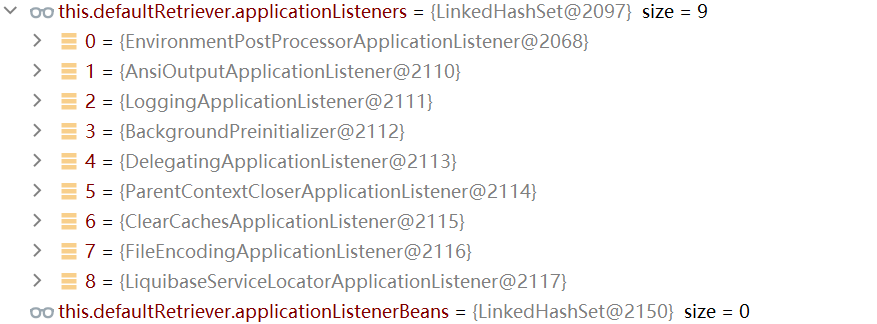
它是从哪儿来的呢?
private final DefaultListenerRetriever defaultRetriever = new DefaultListenerRetriever();
/** * Helper class that encapsulates a general set of target listeners. */ private class DefaultListenerRetriever { public final Set<ApplicationListener<?>> applicationListeners = new LinkedHashSet<>(); public final Set<String> applicationListenerBeans = new LinkedHashSet<>(); public Collection<ApplicationListener<?>> getApplicationListeners() { List<ApplicationListener<?>> allListeners = new ArrayList<>( this.applicationListeners.size() + this.applicationListenerBeans.size()); allListeners.addAll(this.applicationListeners); if (!this.applicationListenerBeans.isEmpty()) { BeanFactory beanFactory = getBeanFactory(); for (String listenerBeanName : this.applicationListenerBeans) { try { ApplicationListener<?> listener = beanFactory.getBean(listenerBeanName, ApplicationListener.class); if (!allListeners.contains(listener)) { allListeners.add(listener); } } catch (NoSuchBeanDefinitionException ex) { // Singleton listener instance (without backing bean definition) disappeared - // probably in the middle of the destruction phase } } } AnnotationAwareOrderComparator.sort(allListeners); return allListeners; } }
这里我们并未找到该值的来源,那我们找一下哪些地方用到了这个defaultRetriever:
@Override public void addApplicationListener(ApplicationListener<?> listener) { synchronized (this.defaultRetriever) { // Explicitly remove target for a proxy, if registered already, // in order to avoid double invocations of the same listener. Object singletonTarget = AopProxyUtils.getSingletonTarget(listener); if (singletonTarget instanceof ApplicationListener) { this.defaultRetriever.applicationListeners.remove(singletonTarget); } this.defaultRetriever.applicationListeners.add(listener); this.retrieverCache.clear(); } }
这里向里面添加listener的,我们再看看有那个地方调用了这个方法:
public EventPublishingRunListener(SpringApplication application, String[] args) { this.application = application; this.args = args; this.initialMulticaster = new SimpleApplicationEventMulticaster(); for (ApplicationListener<?> listener : application.getListeners()) { this.initialMulticaster.addApplicationListener(listener); } }
发现原来是在最开始初始化EventPublishRunListener的时候添加的。
接下来就是判断是否支持事件,添加到对应的listeners中去,另外由于listenersBean是空的,所以没啥好说的。
我们直接看返回结果:
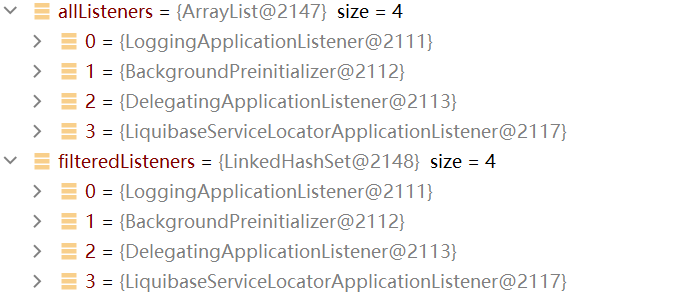
分析这么多,我们终于可以回到以下代码了:
@Override public void multicastEvent(final ApplicationEvent event, @Nullable ResolvableType eventType) { ResolvableType type = (eventType != null ? eventType : resolveDefaultEventType(event)); Executor executor = getTaskExecutor(); for (ApplicationListener<?> listener : getApplicationListeners(event, type)) { if (executor != null) { executor.execute(() -> invokeListener(listener, event)); } else { invokeListener(listener, event); } } }
/** * Invoke the given listener with the given event. * @param listener the ApplicationListener to invoke * @param event the current event to propagate * @since 4.1 */ protected void invokeListener(ApplicationListener<?> listener, ApplicationEvent event) { ErrorHandler errorHandler = getErrorHandler(); if (errorHandler != null) { try { doInvokeListener(listener, event); } catch (Throwable err) { errorHandler.handleError(err); } } else { doInvokeListener(listener, event); } }
@SuppressWarnings({"rawtypes", "unchecked"})
private void doInvokeListener(ApplicationListener listener, ApplicationEvent event) {
try {
listener.onApplicationEvent(event);
}
catch (ClassCastException ex) {
String msg = ex.getMessage();
if (msg == null || matchesClassCastMessage(msg, event.getClass()) ||
(event instanceof PayloadApplicationEvent &&
matchesClassCastMessage(msg, ((PayloadApplicationEvent) event).getPayload().getClass()))) {
// Possibly a lambda-defined listener which we could not resolve the generic event type for
// -> let's suppress the exception.
Log loggerToUse = this.lazyLogger;
if (loggerToUse == null) {
loggerToUse = LogFactory.getLog(getClass());
this.lazyLogger = loggerToUse;
}
if (loggerToUse.isTraceEnabled()) {
loggerToUse.trace("Non-matching event type for listener: " + listener, ex);
}
}
else {
throw ex;
}
}
}
最终调用的是onApplicationEvent方法,不同的listener该方法不一样:




以上就是为了让listeners跑起来,除了第一个初始化了日志系统,其他的执行都是false,啥也没干哈哈。
可能我想要的东西在下面,接下来我们看看run方法中try语句块的代码:
try { ApplicationArguments applicationArguments = new DefaultApplicationArguments(args); ConfigurableEnvironment environment = prepareEnvironment(listeners, bootstrapContext, applicationArguments); configureIgnoreBeanInfo(environment); Banner printedBanner = printBanner(environment); context = createApplicationContext(); context.setApplicationStartup(this.applicationStartup); prepareContext(bootstrapContext, context, environment, listeners, applicationArguments, printedBanner); refreshContext(context); afterRefresh(context, applicationArguments); stopWatch.stop(); if (this.logStartupInfo) { new StartupInfoLogger(this.mainApplicationClass).logStarted(getApplicationLog(), stopWatch); } listeners.started(context); callRunners(context, applicationArguments); } catch (Throwable ex) { handleRunFailure(context, ex, listeners); throw new IllegalStateException(ex); } try { listeners.running(context); } catch (Throwable ex) { handleRunFailure(context, ex, null); throw new IllegalStateException(ex); } return context;
我们先来看下DefaultApplicationArguments构造函数:
public DefaultApplicationArguments(String... args) { Assert.notNull(args, "Args must not be null"); this.source = new Source(args); this.args = args; }
很简单的赋值函数,接下来我们看看prepareEnvironment方法:
private ConfigurableEnvironment prepareEnvironment(SpringApplicationRunListeners listeners, DefaultBootstrapContext bootstrapContext, ApplicationArguments applicationArguments) { // Create and configure the environment ConfigurableEnvironment environment = getOrCreateEnvironment(); configureEnvironment(environment, applicationArguments.getSourceArgs()); ConfigurationPropertySources.attach(environment); listeners.environmentPrepared(bootstrapContext, environment); DefaultPropertiesPropertySource.moveToEnd(environment); bindToSpringApplication(environment); if (!this.isCustomEnvironment) { environment = new EnvironmentConverter(getClassLoader()).convertEnvironmentIfNecessary(environment, deduceEnvironmentClass()); } ConfigurationPropertySources.attach(environment); return environment; }
我们看看environment是什么:
private ConfigurableEnvironment getOrCreateEnvironment() { if (this.environment != null) { return this.environment; } switch (this.webApplicationType) { case SERVLET: return new StandardServletEnvironment(); case REACTIVE: return new StandardReactiveWebEnvironment(); default: return new StandardEnvironment(); } }
首先我们先回到SpringApplication的构造函数:
/** * Create a new {@link SpringApplication} instance. The application context will load * beans from the specified primary sources (see {@link SpringApplication class-level} * documentation for details. The instance can be customized before calling * {@link #run(String...)}. * @param resourceLoader the resource loader to use * @param primarySources the primary bean sources * @see #run(Class, String[]) * @see #setSources(Set) */ @SuppressWarnings({ "unchecked", "rawtypes" }) public SpringApplication(ResourceLoader resourceLoader, Class<?>... primarySources) { this.resourceLoader = resourceLoader; Assert.notNull(primarySources, "PrimarySources must not be null"); this.primarySources = new LinkedHashSet<>(Arrays.asList(primarySources)); this.webApplicationType = WebApplicationType.deduceFromClasspath(); this.bootstrapRegistryInitializers = getBootstrapRegistryInitializersFromSpringFactories(); setInitializers((Collection) getSpringFactoriesInstances(ApplicationContextInitializer.class)); setListeners((Collection) getSpringFactoriesInstances(ApplicationListener.class)); this.mainApplicationClass = deduceMainApplicationClass(); }
并没有初始化environment,也没有默认值,从之前Debud的结果也可以看出来,我们看看deduceFromClasspath方法:
static WebApplicationType deduceFromClasspath() { if (ClassUtils.isPresent(WEBFLUX_INDICATOR_CLASS, null) && !ClassUtils.isPresent(WEBMVC_INDICATOR_CLASS, null) && !ClassUtils.isPresent(JERSEY_INDICATOR_CLASS, null)) { return WebApplicationType.REACTIVE; } for (String className : SERVLET_INDICATOR_CLASSES) { if (!ClassUtils.isPresent(className, null)) { return WebApplicationType.NONE; } } return WebApplicationType.SERVLET; }
反正这个也是通过ClassUtils来判断环境是啥,最后返回的是WebApplicationType.SERVLET。
接下来看看configureEnvironment方法:
/** * Template method delegating to * {@link #configurePropertySources(ConfigurableEnvironment, String[])} and * {@link #configureProfiles(ConfigurableEnvironment, String[])} in that order. * Override this method for complete control over Environment customization, or one of * the above for fine-grained control over property sources or profiles, respectively. * @param environment this application's environment * @param args arguments passed to the {@code run} method * @see #configureProfiles(ConfigurableEnvironment, String[]) * @see #configurePropertySources(ConfigurableEnvironment, String[]) */ protected void configureEnvironment(ConfigurableEnvironment environment, String[] args) { if (this.addConversionService) { ConversionService conversionService = ApplicationConversionService.getSharedInstance(); environment.setConversionService((ConfigurableConversionService) conversionService); } configurePropertySources(environment, args); configureProfiles(environment, args); }
由于addConversionService默认是true,我们接下来看看getSharedInstance方法:
/** * Return a shared default application {@code ConversionService} instance, lazily * building it once needed. * <p> * Note: This method actually returns an {@link ApplicationConversionService} * instance. However, the {@code ConversionService} signature has been preserved for * binary compatibility. * @return the shared {@code ApplicationConversionService} instance (never * {@code null}) */ public static ConversionService getSharedInstance() { ApplicationConversionService sharedInstance = ApplicationConversionService.sharedInstance; if (sharedInstance == null) { synchronized (ApplicationConversionService.class) { sharedInstance = ApplicationConversionService.sharedInstance; if (sharedInstance == null) { sharedInstance = new ApplicationConversionService(); ApplicationConversionService.sharedInstance = sharedInstance; } } } return sharedInstance; }
private static volatile ApplicationConversionService sharedInstance;
既然该方法用到了锁,我们就当他是线程安全的方法来分析:(对sharedInstance读和写只在这个方法里)
为什么这里在锁后要再读一次呢,因为最先获取锁的线程初始化过了,所以不用再初始化。
public ApplicationConversionService() { this(null); }
public ApplicationConversionService(StringValueResolver embeddedValueResolver) { if (embeddedValueResolver != null) { setEmbeddedValueResolver(embeddedValueResolver); } configure(this); }
/** * Configure the given {@link FormatterRegistry} with formatters and converters * appropriate for most Spring Boot applications. * @param registry the registry of converters to add to (must also be castable to * ConversionService, e.g. being a {@link ConfigurableConversionService}) * @throws ClassCastException if the given FormatterRegistry could not be cast to a * ConversionService */ public static void configure(FormatterRegistry registry) { DefaultConversionService.addDefaultConverters(registry); DefaultFormattingConversionService.addDefaultFormatters(registry); addApplicationFormatters(registry); addApplicationConverters(registry); }
反正就是初始化一个格式转换器,具体干嘛用的也不知道,看下一行代码吧:
/** * Add, remove or re-order any {@link PropertySource}s in this application's * environment. * @param environment this application's environment * @param args arguments passed to the {@code run} method * @see #configureEnvironment(ConfigurableEnvironment, String[]) */ protected void configurePropertySources(ConfigurableEnvironment environment, String[] args) { MutablePropertySources sources = environment.getPropertySources(); if (!CollectionUtils.isEmpty(this.defaultProperties)) { DefaultPropertiesPropertySource.addOrMerge(this.defaultProperties, sources); } if (this.addCommandLineProperties && args.length > 0) { String name = CommandLinePropertySource.COMMAND_LINE_PROPERTY_SOURCE_NAME; if (sources.contains(name)) { PropertySource<?> source = sources.get(name); CompositePropertySource composite = new CompositePropertySource(name); composite.addPropertySource( new SimpleCommandLinePropertySource("springApplicationCommandLineArgs", args)); composite.addPropertySource(source); sources.replace(name, composite); } else { sources.addFirst(new SimpleCommandLinePropertySource(args)); } } }
这个函数由于都是false,相当于什么都没执行,configureProfiles方法是个空函数,我们回到attach方法:
/** * Attach a {@link ConfigurationPropertySource} support to the specified * {@link Environment}. Adapts each {@link PropertySource} managed by the environment * to a {@link ConfigurationPropertySource} and allows classic * {@link PropertySourcesPropertyResolver} calls to resolve using * {@link ConfigurationPropertyName configuration property names}. * <p> * The attached resolver will dynamically track any additions or removals from the * underlying {@link Environment} property sources. * @param environment the source environment (must be an instance of * {@link ConfigurableEnvironment}) * @see #get(Environment) */ public static void attach(Environment environment) { Assert.isInstanceOf(ConfigurableEnvironment.class, environment); MutablePropertySources sources = ((ConfigurableEnvironment) environment).getPropertySources(); PropertySource<?> attached = sources.get(ATTACHED_PROPERTY_SOURCE_NAME); if (attached != null && attached.getSource() != sources) { sources.remove(ATTACHED_PROPERTY_SOURCE_NAME); attached = null; } if (attached == null) { sources.addFirst(new ConfigurationPropertySourcesPropertySource(ATTACHED_PROPERTY_SOURCE_NAME, new SpringConfigurationPropertySources(sources))); } }
oh,shit English,what's mean?大致意思好像是适配环境的,跳过:
void environmentPrepared(ConfigurableBootstrapContext bootstrapContext, ConfigurableEnvironment environment) { doWithListeners("spring.boot.application.environment-prepared", (listener) -> listener.environmentPrepared(bootstrapContext, environment)); }
private void doWithListeners(String stepName, Consumer<SpringApplicationRunListener> listenerAction) { doWithListeners(stepName, listenerAction, null); }
private void doWithListeners(String stepName, Consumer<SpringApplicationRunListener> listenerAction, Consumer<StartupStep> stepAction) { StartupStep step = this.applicationStartup.start(stepName); this.listeners.forEach(listenerAction); if (stepAction != null) { stepAction.accept(step); } step.end(); }
仿佛又回到了原来的方法,只是稍有变动:
@Override public void environmentPrepared(ConfigurableBootstrapContext bootstrapContext, ConfigurableEnvironment environment) { this.initialMulticaster.multicastEvent( new ApplicationEnvironmentPreparedEvent(bootstrapContext, this.application, this.args, environment)); }
@Override public void multicastEvent(ApplicationEvent event) { multicastEvent(event, resolveDefaultEventType(event)); } @Override public void multicastEvent(final ApplicationEvent event, @Nullable ResolvableType eventType) { ResolvableType type = (eventType != null ? eventType : resolveDefaultEventType(event)); Executor executor = getTaskExecutor(); for (ApplicationListener<?> listener : getApplicationListeners(event, type)) { if (executor != null) { executor.execute(() -> invokeListener(listener, event)); } else { invokeListener(listener, event); } } }
不过最终都是调用的multicastEvent方法,我们直接看getApplicationListeners的返回结果吧:

这次返回了六个listener,比上次多两个,而且有重复的,最后还是调用这个方法:
@SuppressWarnings({"rawtypes", "unchecked"})
private void doInvokeListener(ApplicationListener listener, ApplicationEvent event) {
try {
listener.onApplicationEvent(event);
}
catch (ClassCastException ex) {
String msg = ex.getMessage();
if (msg == null || matchesClassCastMessage(msg, event.getClass()) ||
(event instanceof PayloadApplicationEvent &&
matchesClassCastMessage(msg, ((PayloadApplicationEvent) event).getPayload().getClass()))) {
// Possibly a lambda-defined listener which we could not resolve the generic event type for
// -> let's suppress the exception.
Log loggerToUse = this.lazyLogger;
if (loggerToUse == null) {
loggerToUse = LogFactory.getLog(getClass());
this.lazyLogger = loggerToUse;
}
if (loggerToUse.isTraceEnabled()) {
loggerToUse.trace("Non-matching event type for listener: " + listener, ex);
}
}
else {
throw ex;
}
}
}
environment这一块我们就不看了吧,现在直接看banner:
private Banner printBanner(ConfigurableEnvironment environment) { if (this.bannerMode == Banner.Mode.OFF) { return null; } ResourceLoader resourceLoader = (this.resourceLoader != null) ? this.resourceLoader : new DefaultResourceLoader(null); SpringApplicationBannerPrinter bannerPrinter = new SpringApplicationBannerPrinter(resourceLoader, this.banner); if (this.bannerMode == Mode.LOG) { return bannerPrinter.print(environment, this.mainApplicationClass, logger); } return bannerPrinter.print(environment, this.mainApplicationClass, System.out); }
由于默认bannerMode为Banner.Mode.CONSOLE,并且resourceLoader为空,resourceLoaser为DefaultResourceLoader。
Banner print(Environment environment, Class<?> sourceClass, PrintStream out) { Banner banner = getBanner(environment); banner.printBanner(environment, sourceClass, out); return new PrintedBanner(banner, sourceClass); }
private Banner getBanner(Environment environment) { Banners banners = new Banners(); banners.addIfNotNull(getImageBanner(environment)); banners.addIfNotNull(getTextBanner(environment)); if (banners.hasAtLeastOneBanner()) { return banners; } if (this.fallbackBanner != null) { return this.fallbackBanner; } return DEFAULT_BANNER; }
如果是图片的话:
private Banner getImageBanner(Environment environment) { String location = environment.getProperty(BANNER_IMAGE_LOCATION_PROPERTY); if (StringUtils.hasLength(location)) { Resource resource = this.resourceLoader.getResource(location); return resource.exists() ? new ImageBanner(resource) : null; } for (String ext : IMAGE_EXTENSION) { Resource resource = this.resourceLoader.getResource("banner." + ext); if (resource.exists()) { return new ImageBanner(resource); } } return null; }
static final String BANNER_IMAGE_LOCATION_PROPERTY = "spring.banner.image.location";
可以通过配置文件路径或者在resource目录下新建一个名为banner,后缀只能为gif、jpg、png的图片。
如果是文本的话:
private Banner getTextBanner(Environment environment) { String location = environment.getProperty(BANNER_LOCATION_PROPERTY, DEFAULT_BANNER_LOCATION); Resource resource = this.resourceLoader.getResource(location); try { if (resource.exists() && !resource.getURL().toExternalForm().contains("liquibase-core")) { return new ResourceBanner(resource); } } catch (IOException ex) { // Ignore } return null; }
static final String BANNER_LOCATION_PROPERTY = "spring.banner.location"; static final String DEFAULT_BANNER_LOCATION = "banner.txt";
也可以通过配置文件路径或者在resource目录下新建一个banner.txt文件。
如果都没有配置并且fallBackBanner为空的话,就返回默认的Banner:
private static final Banner DEFAULT_BANNER = new SpringBootBanner();
我们看看默认的banner的printBanner方法:
@Override public void printBanner(Environment environment, Class<?> sourceClass, PrintStream printStream) { for (String line : BANNER) { printStream.println(line); } String version = SpringBootVersion.getVersion(); version = (version != null) ? " (v" + version + ")" : ""; StringBuilder padding = new StringBuilder(); while (padding.length() < STRAP_LINE_SIZE - (version.length() + SPRING_BOOT.length())) { padding.append(" "); } printStream.println(AnsiOutput.toString(AnsiColor.GREEN, SPRING_BOOT, AnsiColor.DEFAULT, padding.toString(), AnsiStyle.FAINT, version)); printStream.println(); }
private static final String[] BANNER = { "", " . ____ _ __ _ _", " /\\ / ___'_ __ _ _(_)_ __ __ _ \ \ \ \", "( ( )\___ | '_ | '_| | '_ \/ _` | \ \ \ \", " \\/ ___)| |_)| | | | | || (_| | ) ) ) )", " ' |____| .__|_| |_|_| |_\__, | / / / /", " =========|_|==============|___/=/_/_/_/" }; private static final String SPRING_BOOT = " :: Spring Boot :: ";
Banner介绍完了,我们接下来看看createApplicationContext方法:
/** * Strategy method used to create the {@link ApplicationContext}. By default this * method will respect any explicitly set application context class or factory before * falling back to a suitable default. * @return the application context (not yet refreshed) * @see #setApplicationContextClass(Class) * @see #setApplicationContextFactory(ApplicationContextFactory) */ protected ConfigurableApplicationContext createApplicationContext() { return this.applicationContextFactory.create(this.webApplicationType); }
最终跳到这个接口方法中:
/** * A default {@link ApplicationContextFactory} implementation that will create an * appropriate context for the {@link WebApplicationType}. */ ApplicationContextFactory DEFAULT = (webApplicationType) -> { try { switch (webApplicationType) { case SERVLET: return new AnnotationConfigServletWebServerApplicationContext(); case REACTIVE: return new AnnotationConfigReactiveWebServerApplicationContext(); default: return new AnnotationConfigApplicationContext(); } } catch (Exception ex) { throw new IllegalStateException("Unable create a default ApplicationContext instance, " + "you may need a custom ApplicationContextFactory", ex); } };
为什么会跳到这个接口方法中呢,因为这个applicationContextFactory指向的就是上面的方法,这个方法名应该可以随便取吧!
private ApplicationContextFactory applicationContextFactory = ApplicationContextFactory.DEFAULT;
因为webApplicationType是SERVLET,所以返回WebServerApplicationContext上下文。
接下来我们看prepareContext方法:
private void prepareContext(DefaultBootstrapContext bootstrapContext, ConfigurableApplicationContext context, ConfigurableEnvironment environment, SpringApplicationRunListeners listeners, ApplicationArguments applicationArguments, Banner printedBanner) { context.setEnvironment(environment); postProcessApplicationContext(context); applyInitializers(context); listeners.contextPrepared(context); bootstrapContext.close(context); if (this.logStartupInfo) { logStartupInfo(context.getParent() == null); logStartupProfileInfo(context); } // Add boot specific singleton beans ConfigurableListableBeanFactory beanFactory = context.getBeanFactory(); beanFactory.registerSingleton("springApplicationArguments", applicationArguments); if (printedBanner != null) { beanFactory.registerSingleton("springBootBanner", printedBanner); } if (beanFactory instanceof DefaultListableBeanFactory) { ((DefaultListableBeanFactory) beanFactory) .setAllowBeanDefinitionOverriding(this.allowBeanDefinitionOverriding); } if (this.lazyInitialization) { context.addBeanFactoryPostProcessor(new LazyInitializationBeanFactoryPostProcessor()); } // Load the sources Set<Object> sources = getAllSources(); Assert.notEmpty(sources, "Sources must not be empty"); load(context, sources.toArray(new Object[0])); listeners.contextLoaded(context); }
我们直接看到postProcessApplicationContext方法:
/** * Apply any relevant post processing the {@link ApplicationContext}. Subclasses can * apply additional processing as required. * @param context the application context */ protected void postProcessApplicationContext(ConfigurableApplicationContext context) { if (this.beanNameGenerator != null) { context.getBeanFactory().registerSingleton(AnnotationConfigUtils.CONFIGURATION_BEAN_NAME_GENERATOR, this.beanNameGenerator); } if (this.resourceLoader != null) { if (context instanceof GenericApplicationContext) { ((GenericApplicationContext) context).setResourceLoader(this.resourceLoader); } if (context instanceof DefaultResourceLoader) { ((DefaultResourceLoader) context).setClassLoader(this.resourceLoader.getClassLoader()); } } if (this.addConversionService) { context.getBeanFactory().setConversionService(ApplicationConversionService.getSharedInstance()); } }
由于beanNameGenerator和resourceLoader都为空,但是addConversionService不为空,所以就设置了一个格式转换器。
然后就是调用applyInitializers方法:
/** * Apply any {@link ApplicationContextInitializer}s to the context before it is * refreshed. * @param context the configured ApplicationContext (not refreshed yet) * @see ConfigurableApplicationContext#refresh() */ @SuppressWarnings({ "rawtypes", "unchecked" }) protected void applyInitializers(ConfigurableApplicationContext context) { for (ApplicationContextInitializer initializer : getInitializers()) { Class<?> requiredType = GenericTypeResolver.resolveTypeArgument(initializer.getClass(), ApplicationContextInitializer.class); Assert.isInstanceOf(requiredType, context, "Unable to call initializer."); initializer.initialize(context); } }
/** * Returns read-only ordered Set of the {@link ApplicationContextInitializer}s that * will be applied to the Spring {@link ApplicationContext}. * @return the initializers */ public Set<ApplicationContextInitializer<?>> getInitializers() { return asUnmodifiableOrderedSet(this.initializers); }
就是调用SpringApplication的initializers的初始化方法,就不介绍了(大家可以自己看看),然后就是contextPrepared方法:
void contextPrepared(ConfigurableApplicationContext context) { doWithListeners("spring.boot.application.context-prepared", (listener) -> listener.contextPrepared(context)); }
还是一样的套路:
private void doWithListeners(String stepName, Consumer<SpringApplicationRunListener> listenerAction) { doWithListeners(stepName, listenerAction, null); } private void doWithListeners(String stepName, Consumer<SpringApplicationRunListener> listenerAction, Consumer<StartupStep> stepAction) { StartupStep step = this.applicationStartup.start(stepName); this.listeners.forEach(listenerAction); if (stepAction != null) { stepAction.accept(step); } step.end(); }
这里也不介绍了,然后就是close方法:
/** * Method to be called when {@link BootstrapContext} is closed and the * {@link ApplicationContext} is prepared. * @param applicationContext the prepared context */ public void close(ConfigurableApplicationContext applicationContext) { this.events.multicastEvent(new BootstrapContextClosedEvent(this, applicationContext)); }
@Override public void multicastEvent(ApplicationEvent event) { multicastEvent(event, resolveDefaultEventType(event)); }
还是一样的套路,不介绍了,我们看后面的代码:
if (this.logStartupInfo) { logStartupInfo(context.getParent() == null); logStartupProfileInfo(context); }
这个是和日志相关的,我们不看了,接下来看看beanFactory相关的:
/** * Return the single internal BeanFactory held by this context * (as ConfigurableListableBeanFactory). */ @Override public final ConfigurableListableBeanFactory getBeanFactory() { return this.beanFactory; }
/** * Create a new GenericApplicationContext. * @see #registerBeanDefinition * @see #refresh */ public GenericApplicationContext() { this.beanFactory = new DefaultListableBeanFactory(); }
反正就是实例化了一个DefaultListableBeanFactory对象,然后通过该实例添加了两个bean。
由于lazyInitialization为false,所以不会执行addBeanFactoryPostProcessor方法,我们直接看load方法:
/** * Load beans into the application context. * @param context the context to load beans into * @param sources the sources to load */ protected void load(ApplicationContext context, Object[] sources) { if (logger.isDebugEnabled()) { logger.debug("Loading source " + StringUtils.arrayToCommaDelimitedString(sources)); } BeanDefinitionLoader loader = createBeanDefinitionLoader(getBeanDefinitionRegistry(context), sources); if (this.beanNameGenerator != null) { loader.setBeanNameGenerator(this.beanNameGenerator); } if (this.resourceLoader != null) { loader.setResourceLoader(this.resourceLoader); } if (this.environment != null) { loader.setEnvironment(this.environment); } loader.load(); }
该方法会加载bean到应用上下文,我们看一下getBeanDefinitionRegistry方法:
/** * Get the bean definition registry. * @param context the application context * @return the BeanDefinitionRegistry if it can be determined */ private BeanDefinitionRegistry getBeanDefinitionRegistry(ApplicationContext context) { if (context instanceof BeanDefinitionRegistry) { return (BeanDefinitionRegistry) context; } if (context instanceof AbstractApplicationContext) { return (BeanDefinitionRegistry) ((AbstractApplicationContext) context).getBeanFactory(); } throw new IllegalStateException("Could not locate BeanDefinitionRegistry"); }
它会直接返回第一个,我们再看看createBeanDefinitionLoader方法:
/** * Factory method used to create the {@link BeanDefinitionLoader}. * @param registry the bean definition registry * @param sources the sources to load * @return the {@link BeanDefinitionLoader} that will be used to load beans */ protected BeanDefinitionLoader createBeanDefinitionLoader(BeanDefinitionRegistry registry, Object[] sources) { return new BeanDefinitionLoader(registry, sources); }
/** * Create a new {@link BeanDefinitionLoader} that will load beans into the specified * {@link BeanDefinitionRegistry}. * @param registry the bean definition registry that will contain the loaded beans * @param sources the bean sources */ BeanDefinitionLoader(BeanDefinitionRegistry registry, Object... sources) { Assert.notNull(registry, "Registry must not be null"); Assert.notEmpty(sources, "Sources must not be empty"); this.sources = sources; this.annotatedReader = new AnnotatedBeanDefinitionReader(registry); this.xmlReader = (XML_ENABLED ? new XmlBeanDefinitionReader(registry) : null); this.groovyReader = (isGroovyPresent() ? new GroovyBeanDefinitionReader(registry) : null); this.scanner = new ClassPathBeanDefinitionScanner(registry); this.scanner.addExcludeFilter(new ClassExcludeFilter(sources)); }
接下来我们直接看load方法,由于beanNameGenerator、resourceLoader和environment都为空:
/** * Load the sources into the reader. */ void load() { for (Object source : this.sources) { load(source); } }
private void load(Object source) { Assert.notNull(source, "Source must not be null"); if (source instanceof Class<?>) { load((Class<?>) source); return; } if (source instanceof Resource) { load((Resource) source); return; } if (source instanceof Package) { load((Package) source); return; } if (source instanceof CharSequence) { load((CharSequence) source); return; } throw new IllegalArgumentException("Invalid source type " + source.getClass()); }

怎么说呢,这个sources只有一个,那就是我的项目主类,很明显这个不是我们想要的问题的答案,接着往下看:
又到了listeners.contextLoaded方法了,为啥说又呢,因为这个还是一样的套路,不说了。
我们接下来回到run方法中的refreshContext方法,据说该方法中包含我们想要的答案(调试了这么久,终于到高潮了啊)
private void refreshContext(ConfigurableApplicationContext context) { if (this.registerShutdownHook) { try { context.registerShutdownHook(); } catch (AccessControlException ex) { // Not allowed in some environments. } } refresh((ApplicationContext) context); }
我们看看registerShutdownHook方法:
/** * Register a shutdown hook {@linkplain Thread#getName() named} * {@code SpringContextShutdownHook} with the JVM runtime, closing this * context on JVM shutdown unless it has already been closed at that time. * <p>Delegates to {@code doClose()} for the actual closing procedure. * @see Runtime#addShutdownHook * @see ConfigurableApplicationContext#SHUTDOWN_HOOK_THREAD_NAME * @see #close() * @see #doClose() */ @Override public void registerShutdownHook() { if (this.shutdownHook == null) { // No shutdown hook registered yet. this.shutdownHook = new Thread(SHUTDOWN_HOOK_THREAD_NAME) { @Override public void run() { synchronized (startupShutdownMonitor) { doClose(); } } }; Runtime.getRuntime().addShutdownHook(this.shutdownHook); } }
反正就是和上面注释说的一样,注册一个关闭上下文的线程,我们直接看refresh方法:
/** * Refresh the underlying {@link ApplicationContext}. * @param applicationContext the application context to refresh */ protected void refresh(ConfigurableApplicationContext applicationContext) { applicationContext.refresh(); }
@Override public final void refresh() throws BeansException, IllegalStateException { try { super.refresh(); } catch (RuntimeException ex) { WebServer webServer = this.webServer; if (webServer != null) { webServer.stop(); } throw ex; } }
好了重点来了,就是下面这一段代码:
@Override public void refresh() throws BeansException, IllegalStateException { synchronized (this.startupShutdownMonitor) { StartupStep contextRefresh = this.applicationStartup.start("spring.context.refresh"); // Prepare this context for refreshing. prepareRefresh(); // Tell the subclass to refresh the internal bean factory. ConfigurableListableBeanFactory beanFactory = obtainFreshBeanFactory(); // Prepare the bean factory for use in this context. prepareBeanFactory(beanFactory); try { // Allows post-processing of the bean factory in context subclasses. postProcessBeanFactory(beanFactory); StartupStep beanPostProcess = this.applicationStartup.start("spring.context.beans.post-process"); // Invoke factory processors registered as beans in the context. invokeBeanFactoryPostProcessors(beanFactory); // Register bean processors that intercept bean creation. registerBeanPostProcessors(beanFactory); beanPostProcess.end(); // Initialize message source for this context. initMessageSource(); // Initialize event multicaster for this context. initApplicationEventMulticaster(); // Initialize other special beans in specific context subclasses. onRefresh(); // Check for listener beans and register them. registerListeners(); // Instantiate all remaining (non-lazy-init) singletons. finishBeanFactoryInitialization(beanFactory); // Last step: publish corresponding event. finishRefresh(); } catch (BeansException ex) { if (logger.isWarnEnabled()) { logger.warn("Exception encountered during context initialization - " + "cancelling refresh attempt: " + ex); } // Destroy already created singletons to avoid dangling resources. destroyBeans(); // Reset 'active' flag. cancelRefresh(ex); // Propagate exception to caller. throw ex; } finally { // Reset common introspection caches in Spring's core, since we // might not ever need metadata for singleton beans anymore... resetCommonCaches(); contextRefresh.end(); } } }
啊,好多呀,不想写了,我们把refresh方法后面的几个方法介绍完吧,refresh留到下一篇介绍。
首先就是afterRefresh,这个方法是空函数:
/** * Called after the context has been refreshed. * @param context the application context * @param args the application arguments */ protected void afterRefresh(ConfigurableApplicationContext context, ApplicationArguments args) { }
没啥好说的,接下来就是stopWatch的stop方法:
/** * Stop the current task. * <p>The results are undefined if timing methods are called without invoking * at least one pair of {@code start()} / {@code stop()} methods. * @see #start() * @see #start(String) */ public void stop() throws IllegalStateException { if (this.currentTaskName == null) { throw new IllegalStateException("Can't stop StopWatch: it's not running"); } long lastTime = System.nanoTime() - this.startTimeNanos; this.totalTimeNanos += lastTime; this.lastTaskInfo = new TaskInfo(this.currentTaskName, lastTime); if (this.keepTaskList) { this.taskList.add(this.lastTaskInfo); } ++this.taskCount; this.currentTaskName = null; }
嗯,就是记录了一下运行时间啥的等等,没啥好讲的。
然后就是日志也没啥好说的,这个listeners见到好多次了都是一个套路,我们跳过他,看看callRunners:
private void callRunners(ApplicationContext context, ApplicationArguments args) { List<Object> runners = new ArrayList<>(); runners.addAll(context.getBeansOfType(ApplicationRunner.class).values()); runners.addAll(context.getBeansOfType(CommandLineRunner.class).values()); AnnotationAwareOrderComparator.sort(runners); for (Object runner : new LinkedHashSet<>(runners)) { if (runner instanceof ApplicationRunner) { callRunner((ApplicationRunner) runner, args); } if (runner instanceof CommandLineRunner) { callRunner((CommandLineRunner) runner, args); } } }
由于runners是一个空数组,我们就不看callRunner了,这个函数就也相当于啥也没干。
至此,整个run方法除了refresh方法就全Debug完了,这么看下去好像也没有什么收获,看不到他的设计思想。